Only One ‘Confused’ is the Mayor: De Blasio Must Make Good on Senior Housing Pledge
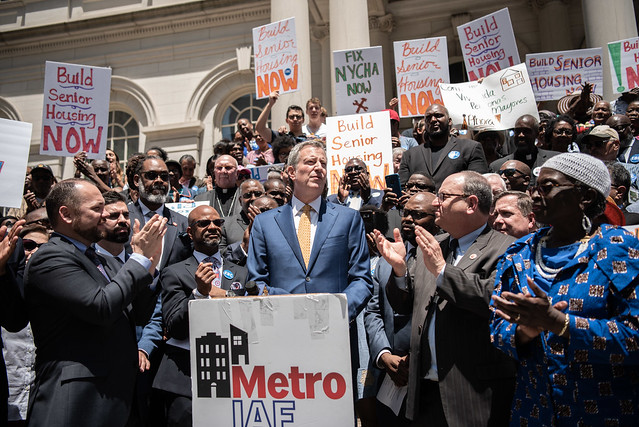
Mayor de Blasio rallies with Metro IAF (photo: Michael Appleton/Mayor's Office)
Last summer, Mayor de Blasio shook our hands and publicly promised to invest $500 million to build thousands of new apartments for low-income seniors. The celebration has been short lived. It turns out the mayor betrayed us and New Yorkers when he reneged on his commitment.
Last Tuesday, more than 500 East Brooklyn Congregations and Metro IAF leaders rallied on the steps of City Hall to get the money our seniors were promised. More importantly, we want the aspiring presidential candidate to come to grips with this cold and hard reality: the tale of two cities has grown worse not better over the past six years.
As pastors, we’ve spent the past 40 years organizing our people and pressuring public officials to deliver for the poor and working class of our city, many of whom worship in our pews or attend our schools.
We’ve had a relationship with every mayor. It’s often been contentious but never duplicitous.
In 1983, after a tough public fight with then-Mayor Ed Koch, we began the construction of what would eventually become more than 5,000 Nehemiah homes and apartments. The Nehemiah plan, named after the prophet who rebuilt Jerusalem, resurrected Brownsville, East New York, and large parts of the South Bronx.
Our city’s seniors will soon number more than 2 million. They stood by our city during the financial crisis of the 1970s, and the murder and drug epidemics of the ‘80s and ‘90s. We have a moral obligation to stand by them as they retire on fixed income and with a diminishing supply of affordable housing.
One of our older members recently confessed that trying to pay her $1,400 monthly rent on a fixed income sometimes forced her to choose between food and rent. We need a new Nehemiah plan for our city's seniors.
Mayor de Blasio came into office with talk of ending the tale of two cities. We believe his intentions were honorable, but, by all measurements, the affordable housing crisis, the dehumanizing conditions in NYCHA, and the future of many poor seniors and students are worse not better.
More than 65,000 of our fellow New Yorkers live in poorly-run shelters or expensive motels. At least 120,000 of our public school students are doubled up with family members or facing evictions.
Think about that. During times of prosperity and abundance, our young scholars are commuting from filthy shelters or far flung places. One of our high school students, her family evicted from their apartment in Bushwick, commutes every day from her relative’s home in Pennsylvania.
There are more than 200,000 seniors on wait-lists to get into affordable housing developments. With wait times as long as five to eight years, many die before they get to move in.
The blame for the housing crisis doesn't start and end at City Hall. Slumlords and mega-developers have learned how to monetize the eviction and displacement of hundreds of thousands of black and Latino families. They might be driving the crisis but the city cannot and must not stand idly by.
We spent two years pressuring and negotiating with the mayor to get him to do something truly transformational. It appeared that the mayor was finally ready.
On a bright sunny day last June, in front of 10 City Council members and hundreds of our members, the mayor promised to invest $500 million to create senior housing on empty NYCHA parking lots.
For every senior that we could voluntarily move out of New York City public housing, we could free up a three or four bedroom apartment for a family to leave the shelter. A $2 billion city investment can create 15,000 new affordable senior housing units which, in turn, can create space for 50,000 New Yorkers to move out of the shelters and off the streets.
The first $500 million can generate 4,000 new seniors units, which would mean that 12,000 or more individuals could get permanent affordable housing in NYCHA.
In a recent letter to Comptroller Stringer, the mayor quietly admitted that the $500 million is not in his budget plan. It’s gone, and so it appears is the mayor’s willingness to help.
We made this announcement at church services across the city over last couple of weeks. As pastors, we have rarely seen our people so angry. The mayor says there’s been unfortunate “confusion” about what he pledged, and claiming that the city's contribution would be much less, closer to $100 million.
We say it is only the mayor who has been confused.
It’s possible that the mayor, like a lot of public officials, never expected to be held accountable for his promise. But he is, and he must deliver.
***
By Rev. Adolphus Lacey, Rev. Shaun J. Lee & Rev. David K. Brawley.
***
Have an op-ed idea or submission for Gotham Gazette? Email This email address is being protected from spambots. You need JavaScript enabled to view it.
The Threat of the Trump Budget to New York City’s Social Safety Net is Very Real
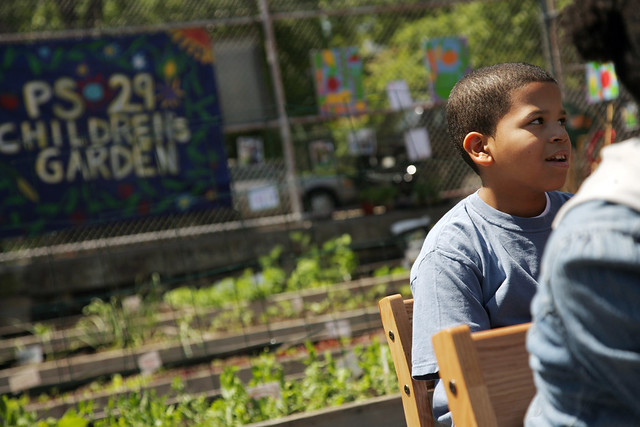
(photo: Ed Reed/Mayor's Office)
Last month, President Trump offered a cynical vision of the future with the release of his fiscal year 2020 budget. If enacted, it would deepen poverty and widen economic and racial disparities by denying millions health care and food, ramping up anti-immigrant enforcement, sabotaging the census, and disinvesting in housing and education. Meanwhile, the proposal prioritizes guns over butter by bloating the military budget and increases tax cuts to high-income taxpayers and heirs to very large estates.
FPWA analyzed the president’s budget by showing both the present danger to New York City and putting the proposal in context with historical funding trends, as illustrated in FPWA’s recently-launched Federal Funds Tracker.
According to our analysis, the proposal would collectively cut federal revenue to a handful of key human service agencies by nearly a half billion dollars (16 percent of their federal revenue) by ending or devastating programs that support the needs of communities, children and older adults, and those who are unable to afford a basic standard of living.
Although the president’s budget is non-binding, it is still of great concern because it is a statement of priorities from the country’s top officeholder, and unless an agreement is made before the coming fiscal year (which begins October 1), Trump’s deep cuts could become reality.
Moreover, a pattern has emerged in which the Trump administration turns to administrative action when its proposals fail to get through Congress, such as the proposed rule that would slash the Supplemental Nutrition Assistance Program (SNAP, formerly food stamps) by making it even harder for unemployed and underemployed workers to access food assistance, including 50,000 New York City residents.
We evaluate the impact of the proposal on the nearly 40 federal grants that support the four New York City agencies featured in the FPWA Federal Funds Tracker – the Administration for Children’s Services (ACS), Department of Youth and Community Development (DYCD), Department for the Aging (DFTA), and Department of Social Services (DSS) – and in turn, the nonprofit human service providers who rely on these grants.
These four agencies’ federal grants represented 38 percent ($2.9 billion) of the City’s total federal grants in FY 2018.
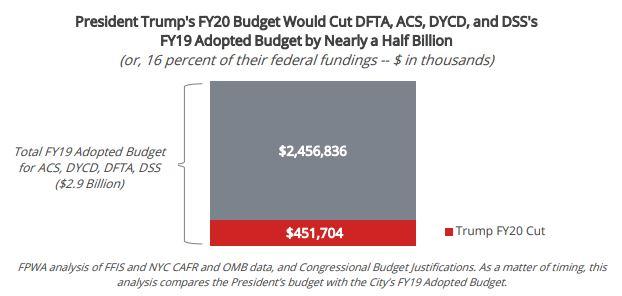
FPWA analysis of FFIS and NYC CAFR and OMB data, and Congressional Budget Justifications
Trump’s FY 2020 vision extends the economic pain that has endured throughout this decade into the next. Our analysis reveals that, adjusting for inflation, all federal grants to the City fell by nearly $2 billion since FY 2010, including hundreds of millions in support for human services.
In large part, disinvestment over the last decade is due to the 2011 Budget Control Act (BCA), which set caps on defense and nondefense discretionary funding through 2021 and further reduced funding over time through across-the-board spending cuts known as sequestration.
This disinvestment has real life consequences. Federal grants are often passed through from City agencies to nonprofit human-service providers to support the needs of their communities and attract and retain qualified staff.
For example, the Chinese-American Planning Council, Inc. relies on federal support to serve more than 60,000 individuals and families across Manhattan, Brooklyn, and Queens. CPC’s federal support would be cut by 44 percent ($2.5 million) under Trump’s budget, driven in part by the proposal to eliminate the Community Services Block Grants.
CSBG – which has already fell by 14 percent since FY 2010 – supports a wide range of community-based activities to reduce poverty, such as CPC’s LEAD program at the High School for Dual Language and Asian Studies. The LEAD program helped a struggling high school student assimilate into a new school, improve her language skills, and ultimately go on to be a successful student.
When the federal government abdicates its responsibility, New York City’s commitment to caring for people who are struggling to afford basic needs means that it is often left to fill the gaps. Indeed, since FY 2010, the City has invested an additional $2.2 billion (nominally) to support these agencies. In other words, the money that New York City spends on human services in the absence of sufficient federal support could be spent on other investments equally important to the City’s quality of life, such as transportation, safety, education, cultural institutions, and the environment.
Americans have already endured nearly a decade of federal austerity. Congress – which has begun work on FY 2020 spending bills – should chart a new vision for the new decade by reaching an agreement that not only reverses course on the planned sequestration cuts but also meaningfully increases support for the woefully underfunded programs that serve low-to middle-income families, and that, when properly funded, strengthen the economy and improve the quality of life for all New Yorkers.
***
Derek Thomas is Senior Fiscal Policy Analyst and Gaurav Gupta-Casale is Fiscal Policy Associate at FPWA. On Twitter @FPWA.
***
Have an op-ed idea or submission for Gotham Gazette? Email This email address is being protected from spambots. You need JavaScript enabled to view it.
SimCity Showed Us Brilliant Civic Tech Interfaces 30 Years Ago. We Should Build Them for Real Now

(SimCity image via nycj blogspot)
I was eight years old when I first encountered a computer game called SimCity. The general premise of the game was that you were the mayor of a virtual city, and you would use game money to create a place for communities of “Sims” to live.
First you set up basic infrastructure like roads, pipes, and zoning and soon after, the “Sims” would arrive to build buildings and pay taxes. As tax revenue flowed in, you would use it to make citywide improvements by establishing public infrastructure like schools, hospitals and parks. The more robust your city’s services, the more Sims would want to live there, and the more tax revenue would roll in. As the game progressed and your city grew, your decisions as mayor became increasingly complex. However, an easy-to-use interface simplified the tasks and made the whole experience a lot of fun.
That was 1994, and at the time, I assumed that one day, my neighbors and I would all have a hand in understanding and shaping New York City through tools and interfaces like SimCity’s. Apparently I wasn't the only one. A recent story in the LA Times claims that "'Sim City' inspired a generation of city planners."
As the internet was getting increasingly popular, my confidence in that idea strengthened. How difficult could it possibly be for the biggest city in the world’s richest country to create “Sim NYCity”?
Apparently it's quite difficult -- not from a technical perspective, but from an organizational development one.
Technically, government agencies have the vast majority of the data SimCity offers to viewers, such as geographic information like zoning and elevation; statistical information like crime and graduation rates and population; and infrastructure monitoring like traffic, electricity use, water flow rates, etc. But bringing it all together to give the residents an intelligible, (relatively) real-time dashboard for seeing their city operate clearly just isn't a priority.
Thanks to the tireless work of open source software developers and open government advocates, we don't have to wait for our city to organize this information for us. We can -- and should -- begin to do it ourselves.
Here are a few of the features that would make "SimNYCity" such a valuable contribution to civic life.
Interactive Community Maps
The centerpiece of the system is a map similar to Google Maps or the City's Planning Lab's new Community District Profiles website. It would have highly curated data layers that display education, health, police, fire and mass transit indicators (in SimCity parlance: data maps), as well as useful demographic information of residents.
Anyone could click a few layers on and off to see which neighborhoods have access to which services, and which don’t. Users could select which facilities they’d like to see added to an area, and then receive a projection of how the addition of such a facility would impact access in the neighborhood. Of course, accurate projections would be difficult to create, but basic estimates wouldn’t be, and more importantly, the existence of such a tool would whet the public’s appetite for more information and involvement in planning processes.
Citizen-Driven Budgets
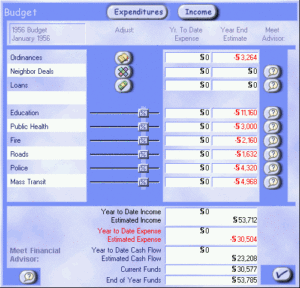
[Offering opinions on the budget could be as easy as pulling a few sliders]
Managing the budget was one of the most important jobs of the mayor in SimCity. The tool for doing this was similar to a mortgage calculator. Income and expenses were presented with about 10 line items each, and you could pull the slider in one direction or another to change funding allocations and see how those allocations impact the entire city's budget.
We should offer a similar tool to New Yorkers. We can synthesize the New York City budget from thousands of line items into a dozen or so, enabling anyone to quickly see how money flows in and out of the city’s government. Then we can invite them to create their budget by pulling sliders. As they do, the city’s budget projections change.
So, if someone would like to increase the education budget they would toggle education to the right. Then they might adjust revenue by increasing taxes to balance the budget. Bonds could be included into the mix too by showing a list of public bond offers and requests. This type of tool would allow New Yorkers to create the budgetary mixes they want to see, and they can share it with others.
We could also generate statistics about all the different budgets New Yorkers create to develop insights about how the city’s budget could more accurately reflect the values of the city's residents.
Decision-Making Moments
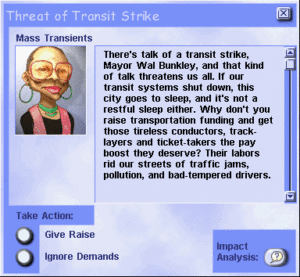
[City advisers could send out messages to New Yorkers and ask for their direct feedback]
When time sensitive decisions were needed in SimCity, a popup would appear with a message from an adviser asking the mayor for a decision. “SimNYCity” could work similarly by providing citizens with more opportunities to indicate their preferences on key civic issues.
For example, when a controversial zoning change is being proposed, an alert from the Commissioner of City Planning could be sent to SimNYCity users saying something like: "Residents are wondering what you plan to do with the Bedford Armory. Here's some information about the various interest groups. Do you think the current proposals should move forward or should it be rewritten?" Users could then say what they think.
This type of feedback could provide useful information for city leaders that they could incorporate into their decision-making processes. A similar workflow could be used for legislative and administrative decision-making.
Moving Beyond the Vote
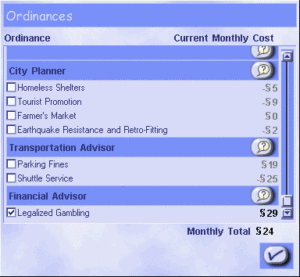
[Imagine if all the active and proposed city ordinances were laid out in a simple list]
Our current democratic processes are, unfortunately, failing New York City. Less than 25% of eligible New Yorkers voted in the 2017 election cycle, in which over 95% of incumbents won their primaries and went on to win uncompetitive general election races. This means that a very small group of Democratic Party insiders are the people determining who will serve in New York City government. That isn’t very democratic, and it's the main reason so few New Yorkers show up to the polls.
We don’t have to wait for deep reforms to our city’s democratic processes before we start experimenting with new and innovative ways to provide participatory democratic experiences to New Yorkers. We can offer citizens methods for engagement right now - and if these methods turn out to be popular, then we can organize the public to pressure existing politicians into incorporating these methods into their decision-making processes.
These are just a few interfaces SimCity has for making cities and their governments more legible, and interacting with them more enjoyable. The technical hurdles to implementing similar interfaces for the city are certainly significant, but not impossible to overcome.
Planning Labs, a digital service organization within New York City’s city planning agency is building open source software and open data resources that could power many of the complicated mapping elements. Furthermore, New York City's Open Data law mandates that much of the information we'd need from the government to build such a system is being published to the city's official Open Data Portal.
Exploring what that data is and how it can be connected together to build the type of deep data resources needed to power interfaces similar to SimCity's is the next step -- and it's work my team at Sarapis has begun to do by extracting and connecting nearly a dozen (and counting!) city datasets together to create data-driven government agency profiles that will make it easier for civic-minded people, especially journalists, to navigate and use for their work.
Through this process, we’re learning what data is and isn't available, how that data can be connected together and visualized to deliver insights to our users, and what next steps need to be taken on the long journey of delivering New Yorkers a SimCity style interfaces for their city.
***
Devin Balkind is the president of Sahana Software Foundation, founder of Sarapis.org, and a former candidate for New York City Public Advocate. He speaks regularly at conferences around the world about using technology to overcome environmental and political crisis. On Twitter @DevinBalkind.
***
Have an op-ed idea or submission for Gotham Gazette? Email This email address is being protected from spambots. You need JavaScript enabled to view it.




